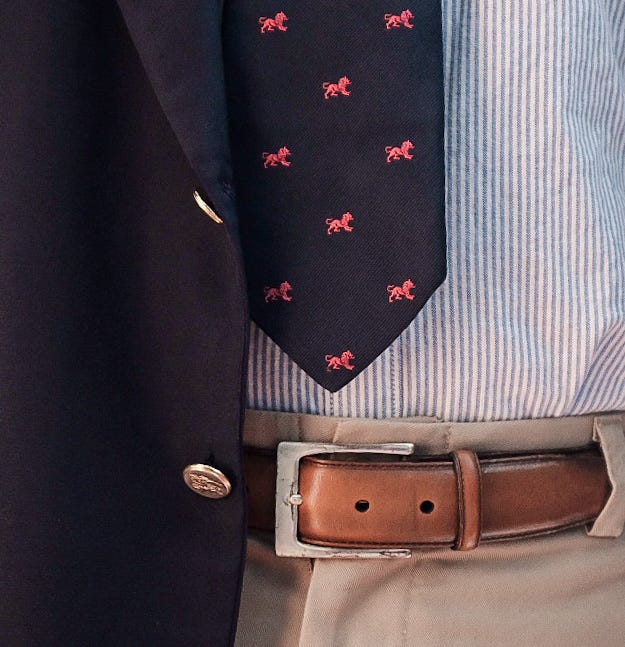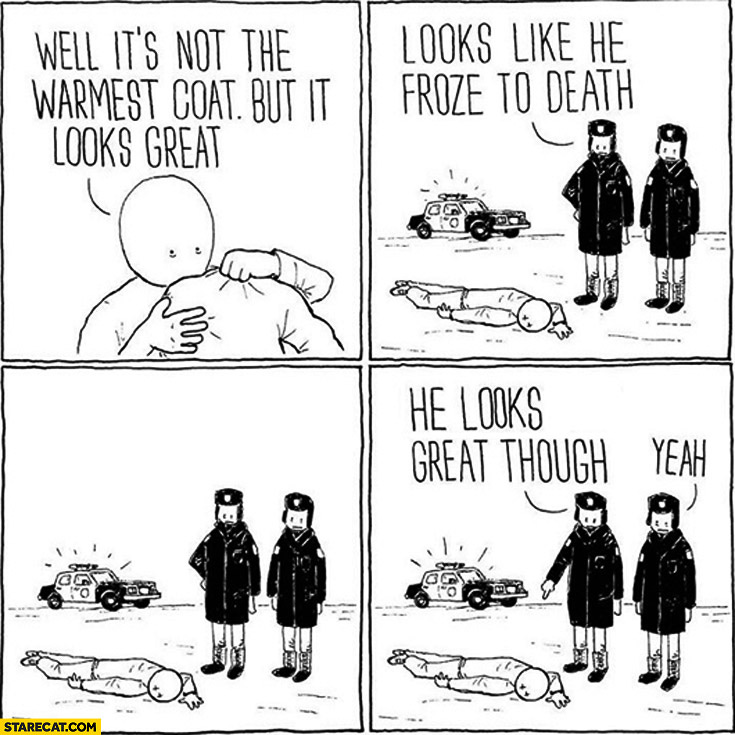If you’ve been following this newsletter for a decent amount of time, you may have noticed that I tend to hold up context as the most important part of an outfit.
If you’re wondering what exactly I mean by this, allow me to offer you a scenario:
You’re invited to a friend’s pool party — do you a) wear a hopsack coat with a 3/2 roll and penny loafers, or do you b) wear a bathing suit paired with a seersucker shirt?
The answer, 10 times out of 10, should be b (obviously).
If you go with option a, you officially transcend the threshold of cringe and you become that guy. It doesn’t matter how good you look in that moment, because you dressed without yielding to the context of your surroundings, ultimately committing a social faux-pas.
The two above examples are extreme illustrations of what I’m trying to say — but what happens with less transparent examples of breaking contextuality? We are living in an increasingly casual world — even the act of wearing a collared shirt can be seen as dressing up to some. In my eyes, this is something brought on by a number of forces, chief of which is the ever-increasing BMI of the American populace.
A combination of screen addiction, torpor, and chemical-slop-for-food has made it a genuine challenge to stay at a healthy weight (whereas before, even as early as the 1980s, you didn’t need to try to be slim, it was simply our default state).
Enter athleisure.
Stretchy waistbands accompanying garments that (and I may be going against the grain here a bit) look pretty decent and rather socially acceptable have “let“ people relax their standards for how they look when they leave the house. In fact, when I go out in my suburban Boston town, it’s just about the only thing I see anymore — even jeans seem comparatively rare, especially since the pandemic struck.
So as we continue to become more casual as a society, what happens to those style niches that skew more formal? Do they just go extinct? It certainly feels like prep and ivy style have been on a march toward extinction for a while now. Specialty brands like Polo Ralph Lauren and Rowing Blazers have helped to keep the spirit of prep alive in America, but what happens if (or when) this trend passes?
This style relies on popular appeal at some level — if the demand for OCBDs becomes so small that no company can justify making them, then they’ll essentially cease to exist — same with any other individual piece of clothing.
I don’t necessarily think that this will happen, as Americana (prep and workwear) are pretty heavily entrenched in the American consciousness, but the shift toward an ever-more casual world is definitely giving me some pause.
At the same time, it seems that people are becoming somewhat sick of athleisure and the general sameness of casual clothing being the norm. From my perspective on the internet, I see a lot of people burnt out from sweatpants and (perhaps more importantly) the endless, incredibly short fashion trend cycles that have sprung up from covid.
*Tangent Time*
You may have heard of such things as cottagecore, or solarpunk, or dark academia, or the old money aesthetic… These are just a few of a massive range of “online aesthetics“ that have been popping up over the last few years.
Hilariously, there’s even a fandom wiki that covers every new aesthetic that’s made up (there’s a lot of them!).
What I find interesting about these aesthetics is that they’re purposely curated to exist outside of what is currently trendy. That’s where my interest generally stops, however — this stuff is seriously inauthentic and probably generates a ton of cognitive dissonance in the people who try to abide by these.
Take for example cottagecore (this is perhaps the biggest online aesthetic): It is at its essence a re-skinned RETVRN TO TRADITION for Gen Z Tumblr girls.
Cottagecore is centered around living in a tiny cottage out in the country, wearing stuff with flowers on it, tending to a garden, botanical illustrations, baking fresh breads, etc. Basically imagine a Hobbit from Lord of the Rings but with a Cluster B personality disorder. All of these things are deliberately anti-trend, putting a simple country life on a pedestal (this is bad for a number of reasons, but is outside the scope of this article).

The cottagecore aesthetic has hundreds of thousands of followers, who, at least on some level, are interested in applying this ideal to themselves, irrespective of what their current life looks like. By choosing cottagecore as their primary aesthetic, they’ve essentially unmoored themselves from the mainstream — this is, at its core, flying in the face of the current neoliberal minimal aesthetic that has dominated social media for the past few years.
The point here is that people are increasingly decoupling themselves from fashion trends and now exist in their own hyper-niche aesthetic communities, where they can wax poetic about shitty poetry or perhaps killing the mothman.
My thoughts (and the reason for the diatribe above) lie in what this means for “acceptable discourse“ when it comes to clothes. At some level formality seems to fall back onto occupation or general level of (socioeconomic or otherwise) class, but even still, most prestige professions (e.g., investment banking or white-shoe law firms) are seriously casualizing their office requirements.
Consider the Overton Window (below): Its purpose is to give a rough map of what is considered acceptable political discourse on the left-right spectrum. Traditionally, there has been a single window that, since the 2000’s, has been ever-creeping leftward. The Trump presidency and covid have, in many people’s eyes, fractured the Overton Window (epistemic divorce below). To clarify, most people who identify as liberal don’t find a single position that a conservative holds to be reasonable, and vice versa.
To make a clunky comparison, it seems that before the death of the media monoculture (i.e., when we sourced our cultural opinions from a single source, e.g., TV), we had a single intact window. Now that media consumption is a little more decentralized, I wonder if we’re witnessing the very beginning of this same idea of epistemic divorce when it comes to fashion.
Will fashion become more multipolar? Will people just accept whatever going forward, or will we always be subjected to the dreaded “why are you so dressed up“? Can I show up to work in my Bigfoot hunting gear (excl. the bear traps)?
I genuinely have no idea — this is pure baseless speculation lol
This is mostly to say that I struggle to find a reason to wear a blazer or sports coat out in public without having to feel a need to justify the decision.
As I get older, I like the idea of a more refined or put-together look, but have reservations about wearing tweed to the dog park (I am only 25 years old (ancient), after all). Maybe it’s simply a matter of “dressing down“ the essentials — perhaps opting for a chore coat instead of a blazer when out in public and similar choices.
Unfortunately for me, I’m an engineer with an incredibly casual office setting — not even the execs wear sports coats (at this point it’s almost sole use in my industry is a LinkedIn headshot), so it’s really daunting to flex that menswear drip.
So I want to leave this one open to you guys, and I genuinely want your feedback here — how do you approach this issue of context? Do you just say screw it and go full trad, do you incorporate the general essence of what you’re going for, or just try to dress toward the expected level of formality for your surroundings? Am I simply overthinking this? Should I just join a country/city club so I have an excuse to dress up?
You tell me.







Hi, Kevin, another thoughtful and insightful entry. “Dressing for context” brings some reality to the whole “menswear” enthusiasm. I think we’d all love to wear Aldens, 3/2 roll blazers and ties every day, but like you, I don’t live in Instagram and am just a lowly operations manager at a university. It can be difficult to wear what we’d truly like, when the rest of the office is in sneakers and anyone who is seen to be putting any effort into their wardrobe is suspect. I typically stick to chinos, an OCBD and blazer most days. No tie, no flashy shoes; a watered down version of what I’d really like to wear.
It’s a sad state of affairs when you feel like you have to dumb down your wardrobe to fit in, but in our society, unfortunately, it’s not just wardrobes that have to be dumbed down. Popular music, literature, film, etc. are all manufactured to appeal to the lowest common denominator. I realize I sound like a snob, but believe it or not, I don’t think I’m better than anyone else. It’s just that most days, I’m glad I’m me.
So I'm over a year late on this (just found your 'stack thanks to a friend's recommendation--absolutely love it).
Up until recently, I was a teacher. One of the things I was excited about in teaching was the chance to dress a bit more formally on a daily basis (I was teaching at a prep school that at the time required faculty to wear either a tie or a sport coat every day except Fridays). I usually stuck with a sport coat and no tie, or else wore a tie and a sweater.
It was exciting at first but quickly became tiring and when the principal altered the dress code to be more casual, I found myself slipping into more casual wear (basically just dropped the tie/blazer except on Mass days). Partially this was social pressure. Most of my coworkers hated the stricter dress code and preferred to be maximally comfortable. I felt weird being relatively pro-strict dress code and I think I internalized a bit of that. Also, I live in Houston and it is dreadfully hot most of the year!
But then I started exercising and watching my diet and lost about 20 or so pounds. All of a sudden my desire to wear nicer clothes came roaring back and hasn't really gone away sense. This, I think, speaks anecdotally to your observation about BMI affecting how much we want to wear nicer clothes.
Now I'm in marketing and have more flexibility in my wardrobe. I've been experimenting with cowboy boots or penny loafers + straight cut jeans + thrifted baggy Ralph Lauren button-downs as a means of dressing a bit more nicely but contextually still fairly casual.
I too would like to live in a social context that demands me to dress a bit better. It's startling how hard it is to motivate yourself to do so when everyone around you is wearing Mizzen + Main performance dress clothes or whatever.